The conspiracy, scouting games and the promise of glory, and then a sea of blood, suffering and death - this is how you can briefly describe the participation of children in the Warsaw Uprising. It is estimated that almost 9,000 of them stood up to fight the Nazis. A lot has paid the highest price for it ...
People in occupied Warsaw could be divided into two camps:the humble, who preferred to wait through the hard times, and those who could not bear the captivity. The latter, hoping for the arrival of the Red Army, decided to organize themselves and once again resist the Germans.
Every man counted, every pair of hands that would soon be erecting barricades, delivering messages, and fighting the enemy. The feeling of patriotic duty, embellished with uniform romanticism, was easy to arouse in the youngest. After all, the war machine ignored age ...
Playing war
Thanks to the newest book by Magdalena Grzebałkowska, Wojenka. About children who grew up without warning " today we have an insight into the terrifying reality of children sucked into the whirlwind of the most tragic conflict in history . The heroes - insurgents who are still alive and who took part in a tragic outburst of resistance in 1944 as minors - tell how they decided to fight at all - with or without a weapon in their hand. Among them is Janina Tatarkiewicz, pseudonym "Myszka". As described by Grzebałkowska:
In 1943, a teacher in secret sets explains to the students that there is an underground scouting - the Gray Ranks. Janina enters, takes the pseudonym "Myszka" and does not reveal at home that she is a girl scout. It acts as a substitute for "Woodpeckers" of the 1st Warsaw Women's Scout Team "Zielona", which is part of the "Wybrzeże Kościuszkowskie" troop.
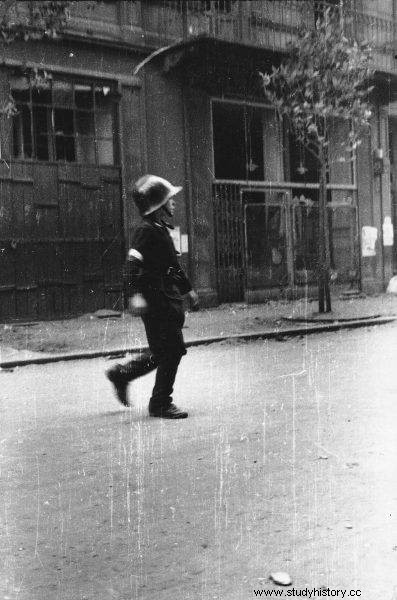
Among the 45,000 insurgents there were 5,840 children aged ten to seventeen, as well as 2,912 eighteen-year-olds.
Should an uprising break out, she will be a liaison. He learns by heart all passages in the tenement houses of Śródmieście, he makes a map of the Mokotów fort. When he has to carry the duplicator in a large flat case, he ties pink bows on the braids to look more childish.
"As if I suddenly grew up"
The beginnings of the military path of young Jan Rybak, pseudonym "Tarzan" looked much more drastic. On October 17, 1943, a fourteen-year-old boy watched the execution of twenty men in a crowd of onlookers. The Germans shot them against the wall and threw the bodies on the trucks. Janek recalled:
It was a shock, people cried, women came up to a pool of blood and dipped handkerchiefs in it . I remember that at that moment I had a strange feeling that nothing would surprise me anymore. It was a turning point for me, as if I suddenly grew up and understood many things.
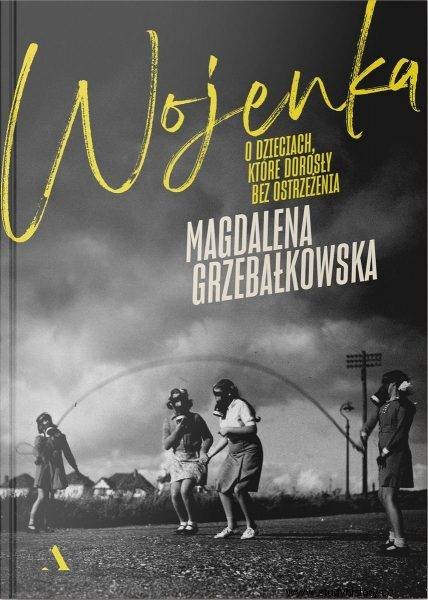
The text was created, among others based on the book by Magdalena Grzebałkowska "Wojenka. About children who grew up without warning ”, which has just been released by Agora publishing house. Buy now
The children were entrusted with all sorts of tasks. "Tarzan" was tearing waybills from wagons at the station and stealing weapons from drunk Germans, "Mouse" was a liaison officer.Many small soldiers also had their own ideas for fighting the invader. Janek Rybak sent reassuring letters to randomly selected residents of Warsaw. Ryszard Sempka, who worked in the workshop, pseudonym "Sztychnicki", damaged generators in German military cars, excluding them from use. Unfortunately, their efforts turned out to be nothing against the huge advantage of the opponent ...
False hope
General "Bór" Komorowski was convinced that the approaching Soviets would help the insurgents defeat the invaders. An additional stimulus for the fight was the growing anxiety of the soldiers of the Third Reich - the troops returning from the Eastern front passed through Warsaw, exhausted, dirty, wounded. Panic was growing among the Nazis. Soon all the German women were evacuated and some officials fled with them.
Magdalena Grzebałkowska in the book "Wojenka. About children who grew up without warning, "she reports:
"Bora" advisers convince him that the capital is about to be deserted and that the uprising will be short-lived and result in a certain victory . Meanwhile, Hitler is not going to surrender to the Russians so easily. He declares Warsaw a city of a fortress and sends several thousand wagons of equipment and ammunition to the east. He is also sending his units, including the elite division "Hermann Göring".
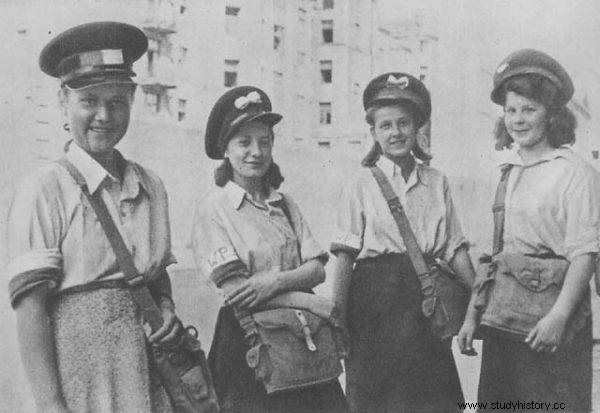
Conspiracy, scouting games and the promise of glory, and then a sea of blood, suffering and death - this is how you can briefly describe the participation of children in the Warsaw Uprising.
The last impulse to start the uprising was the report of Colonel Antoni Chruściel, pseudonym "Monter". He cycled to Praga and watched the banks of the Vistula River. It seemed to him that the Soviets had already broken through the German defense. Hearing this, Komorowski set the date of the uprising to start on August 1 at 5 p.m. All hell broke loose soon after.
Did that heart break?
The dream of deliverance faded like morning mist. Equipped with more effective weapons and much better prepared to fight, the Germans began to suppress the Warsaw Uprising. Many desperately fighting Poles died - in collapsed buildings, from bullets, tank missiles or rocket launchers.
In August 1944, 900,000 to 1,100,000 people lived in occupied Warsaw. About 180,000 of them had died by the end of October. Among the 45,000 insurgents there were 5,840 children aged ten to seventeen, as well as 2,912 eighteen-year-olds . There were also younger little soldiers. How many of them exactly lost their lives during the uprising? We will never know that. It is known, however, that 18,000 insurgents were killed in combat and 25,000 were injured.
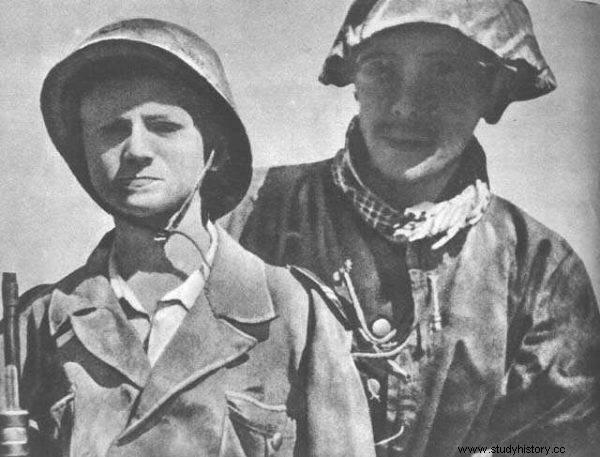
It was often different with older children. Many adolescents took direct part in the Uprising.
In Norman Davies' book "Uprising '44" we can read the account of Andrzej Janicki, pseudonym "Żuliński":
The poorest were the little children, intimidated, so often very hungry and unable to understand why such terrible things were happening around them. I felt so sorry for these children…
It was often different with older children. Many adolescents took direct part in the Uprising. As messengers, they enthusiastically carried weapons, reports, orders and the press. Many of them died… Often they did not realize the danger and were more prone to daring stunts than us older ones .
"I have always carried the sight of those bodies with me"
The lucky few who managed to survive the hell in Warsaw told Magdalena Grzebałkowska about it. This is how "Mouse" reported the bombing with the Nebelwerfer rocket launcher:
The cow spills kerosene, which within two hundred meters is causing hell. He breaks walls and ceilings, burns people alive. He can kill by a blast, tear off clothes, stick sand from the street into the body. In the epicenter of the explosion, sudden pressure changes develop, causing the alveoli and blood vessels to burst. […]
I saw cows prey. Burned people, pitch black. Only their lips were pink and they squeaked through them:"Hush, hush, huh". They had to endure the pain because there was no morphine. They were hung in sheets soaked in linseed oil between the chairs to somehow ease their suffering. Everyone was dying. People are surprised that I am a pessimist all my life. Inside, I remained a small child, mentally crippled. I have always carried the view of those bodies with me .
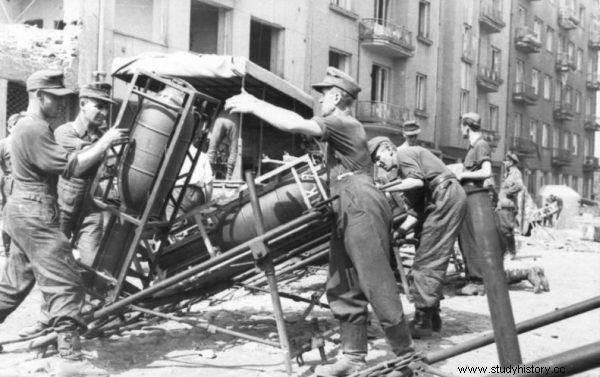
I've seen cow victims. Burned people, pitch black. Only their lips were pink and they squeaked through them:"Hush, hush, huh". They had to endure the pain because there was no morphine.
"Sztychnicki" survived only thanks to a stroke of luck. However, he lost many of his colleagues from the detachment that fell on duty on Kilińskiego Street on August 13. "I have not heard such a noise suddenly from the Kiliński side, but every day cows were flying at us" - he said.
The tragedy happened during an attempt to return a heavy cargo transporter that the Germans abandoned that morning at the barricade in Podwale. About five o'clock it was taken over by the insurgents; they traveled around the Old Town, to the delight of Warsaw residents. Suddenly, a metal box slipped from the hood of the vehicle on Kilinskiego Street. There were 500 kilos of explosives inside.
About 300 people were killed in the explosion and several hundred were injured. Fragments of torn bodies were scattered across the radius of several streets. Fragments of the corpse covered the window sills, hung from the cornices and gutters ...
Heaps of dead people
The nightmare did not end with the cessation of fighting. In early autumn, groups of refugees were chased through the surviving factory halls where hundreds of execution victims were buried. Eight-year-old Andrzej Bober recalled how his mother somehow tried to save him from a terrible experience:
- Andrzej, head up! Head's up! My mother cries. Hundreds of people walk silently around Żoliborz's neighbors, casual acquaintances, corner shop vendors, walkers in the park, coal and milk suppliers, teachers and relatives. Shoes slip on their faces, heels get tangled in their hair, wade among arms and legs .
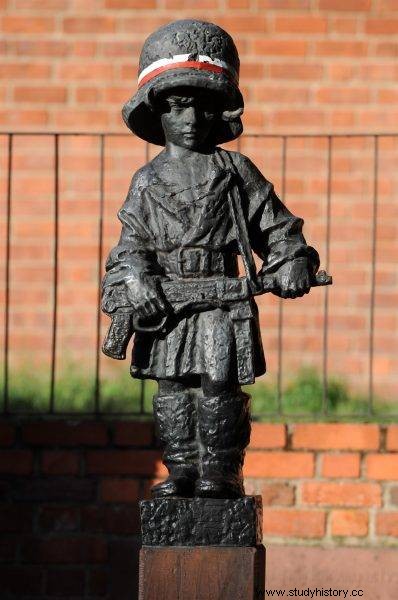
Monument to the Little Insurgent from 1983 at ul. Podwale in Warsaw
Those who were able to report on the terrible events during the Warsaw Uprising were very lucky. They survived.
"Tarzan" and "Mouse" even found their parents. "Sztychnicki" was sent to the Mauthausen camp and worked in a quarry, later he was deliberately infected with phlegmon with streptococcus. The Americans liberated him, but he never saw his sisters or mother again.
